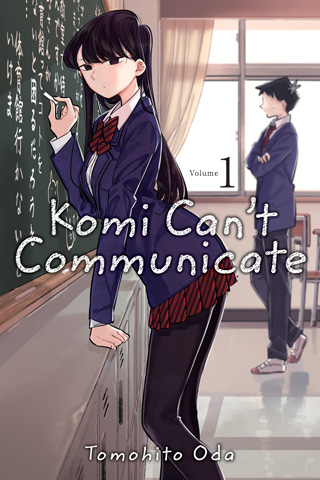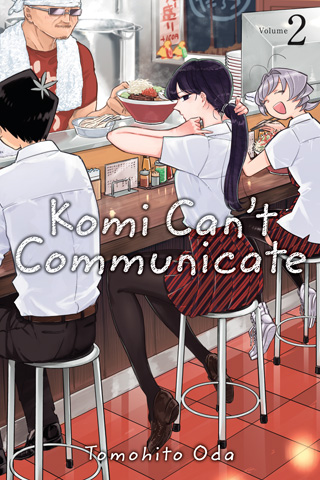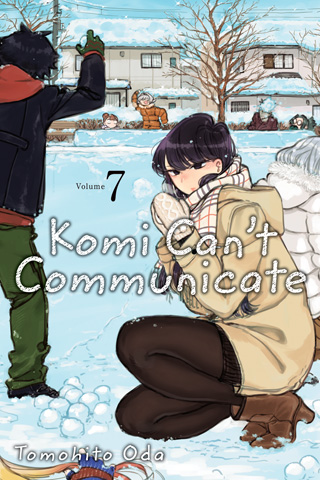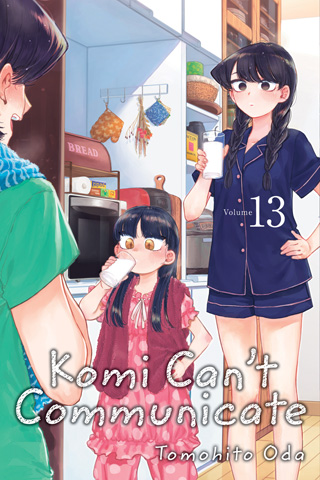Tomohito Oda’s Komi Can’t Communicate focusses on a boy helping a girl navigate through high school life. It is a friendship story that has the distinct twist of the girl, Komi, being excessively shy. This social anxiety, for all intents and purposes, renders her mute. While Komi is able to speak she finds herself heavily reliant on a notebook in order to convey what she is thinking in the present moment. Tadano, the high school boy, notices this and takes it upon himself to help her overcome her inability to speak to others, to make friends, and to improve her life. Its comedy in itself is standard fare, and nothing too unexpected compared to other comedy manga. These types of stories are portrayed lightheartedly with no detrimental stakes potentially impacting the characters’ ultimate well-being. While there is conflict, it is still meant to be a break from any other more dramatic manga the readers might be enjoying at the same time.

Komi Can’t Communicate, builds comedy around Komi’s attribute of excessive shyness in a more positive way. Nobody sees her as shy; they see her as unapproachable due to her beauty The humour is not trying to make fun of somebody or derive pleasure from their discomfort, It is about her over-analyzing her social situations around her to a fault, and the misunderstandings that arrive because of a combination of this and her shyness working in tandem. Take away her own insecurities about herself, and nobody would actively see any flaws in her personality.
Komi Can’t Communicate is told mainly from the perspective of Tadano and Komi. But by no means is it limited to them. In fact, while they are never sidelined as characters, the supporting cast becomes enormous. Some characters get recurring roles, some get used only once or twice, and some are originally recurring characters only to get put aside, only to spontaneously make reappearances later on in the story – several dozen chapters down the road. Before these characters come into play, the story firmly establishes that the main plot will be about Komi trying to achieve her goals.

The first goal is to overcome her shyness. The second is to make 100 friends, though that is a contentious statement since the standard she adopts for this is to consider people she met and interacted with briefly as friends. While a lot of these “friends2 then are really just acquaintances, especially since some of them have managed to anger her in some extreme way, it really is the thought of socializing that counts. People hold her in high esteem due to her unrivalled beauty, kindness, and athleticism – with an especially accented fixation on her beauty. They view her as “perfection” in a sense, so they misdiagnose her shyness as her simply being in her own world, thinking herself too good for everybody else. The truth, ironically, is that she would like nothing more than to interact with her fellow classmates as much as possible. Despite her reliance on her notebook to communicate and being effectively mute, her talents outshine that social stigma, and that is a key take home message for readers of all ages. Her debilitating social anxiety does not define her, but is merely part of the amazing image others perceive.
It soon becomes apparent that the students don’t ignore Komi’s social anxiety simply because she is beautiful. Others are treated the same way too. For readers who assumed that Komi is only able to outweigh her disability due to her other exceptional talents, they are in for a pleasant surprise as the other side characters come in. One of them also has a “flaw” she dislikes about herself. One girl is trying to hide the fact that she is from the countryside. Her accent makes it painstakingly obvious she is indeed from the country, and she has failed in every conceivable way to hide this part of herself that embarrasses her. Nobody makes fun of her for it either. It is never brought up by anybody but her. Three of the boys in class, while fantasizing romance scenarios with their female classmates, include her in one of them, briefly gloss over the fact that her attempts to hide from the country are completely ineffective, and accept her in their fantasy the same as the other city girls. Komi, the one person this girl is most afraid will find out about her secret, brings up the fact that she knows, and does not care either.

Yet another character overly indulges in fantasy scenarios. These people are dubbed “chunni” by Japanese society. She dresses up in outlandish costumes and references obscure vocabulary more suited to being part of a video game. While it is acknowledged that she is indeed a “chunni” by other people, and while she knows it herself and has doubts, it does not actually have any visible effects on her social standing. Three different girls in this story all have what they or others would perceive as “personality flaws, yet they are downplayed or treated as unique positives innate in their character. Loving yourself is accepting who you are, and knowing you can change to become even better. This story does an exemplary job demonstrating this concept throughout its many chapters.
The cast also includes the first friend Komi and Tadano make, the androgynous Osana Najimi, who acts as a mentor towards Komi, seeing as how she has 5 million friends, literally. There is also Yamai Ren, Komi’s biggest worshipper who will commit illegal activities to get close to Komi, and Komi Shouko, the incredibly talented and handsome brother of Komi. Finally, the third main character that gets introduced later on in the story is Manbagi Rumiko, a fashion-oriented girl who eventually competes with Komi to become Tadano’s love interest.

While Komi’s social skills gradually improve and she starts to make friends, there are potential conflicts in the story the beginner reader contends with. Will Tadano and Komi, as it has been teased, eventually become a couple? Will the fashion-oriented Rumiko be Tadano’s love interest instead, and the dynamic between Komi and Tadano will stay as friends? Will Komi make 100 friends before the series ends? Will Komi be able to fully overcome her shyness to one day no longer need a notebook? Finally, will Komi ever stop spouting cat ears? And yes, that is a recurring gag of this manga.
The way her omnipresent social anxiety has no real implication for how people treat her, is a good message for readers of all ages. The treatment of other students, with their own flaws, are a standard to be followed. Komi Can’t Communicate is a manga series that hooks you with the beauty of Komi, but ultimately gets you to stay to watch her develop as a person. The rest of the cast, and their own developing stories, are not easily missed either.
Tomohito Oda (W/A) • Viz Media, $9.99 per volume
Review by Anson Leung















[…] Komi Can’t Communicate (Anson Leung, Broken Frontier) […]